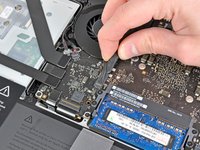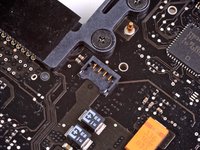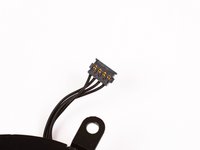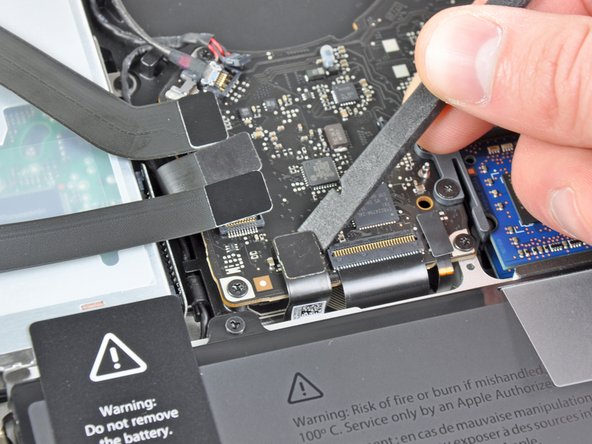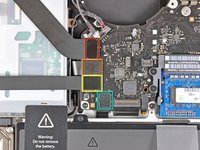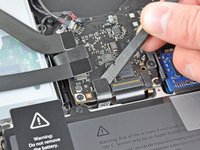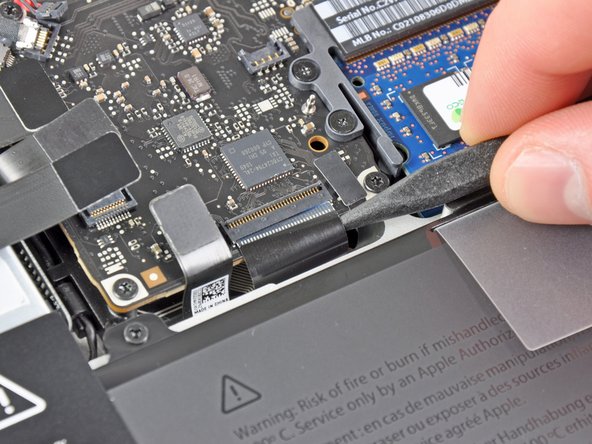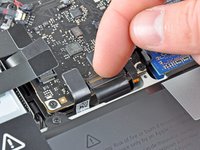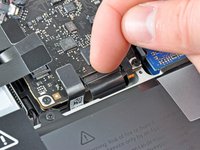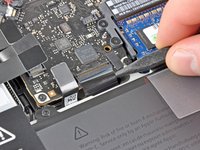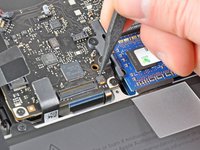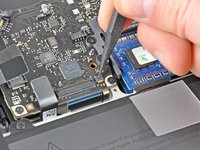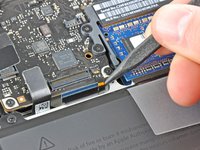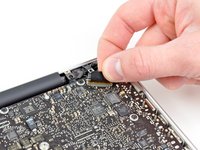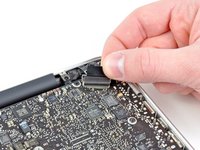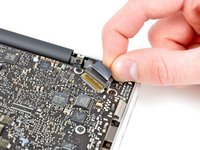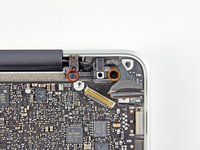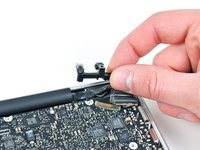crwdns2915892:0crwdne2915892:0
Are the gobs of OEM thermal paste causing your MacBook Pro to be sluggish while hot? Use this guide to remove your heat sink and apply new thermal paste.
crwdns2942213:0crwdne2942213:0
-
-
Remove the following ten screws:
-
Three 14.4 mm Phillips #00 screws
-
Three 3.5 mm Phillips #00 screws
-
Four 3.5 mm shouldered Phillips #00 screws
-
-
-
Use your fingers to pry the lower case away from the body of the MacBook near the vent.
-
Remove the lower case.
-
-
-
Use the edge of a spudger to pry the battery connector upwards from its socket on the logic board.
-
-
-
Bend the battery cable slightly away from its socket on the logic board so it does not accidentally connect itself while you work.
-
-
-
Use the edge of a spudger to gently pry the fan connector up and out of its socket on the logic board.
-
-
-
Remove the following three screws securing the fan to the logic board:
-
One 7.2 mm T6 Torx screw
-
Two 5.3 mm T6 Torx screws
-
-
-
Lift the fan out of its recess in the logic board, minding its cable that may get caught.
-
-
-
-
Use the tip of a spudger to pull the right speaker/subwoofer cable out from under the retaining finger molded into the upper case.
-
Pull the right speaker/subwoofer cable upward to lift the connector out of its socket on the logic board.
-
-
-
Disconnect the camera cable from the logic board.
-
-
-
Disconnect the following four cables:
-
AirPort/Bluetooth cable
-
Optical drive cable
-
Hard drive cable
-
Trackpad cable
-
-
-
Use your fingernail to flip up the retaining flap on the keyboard ribbon cable ZIF socket.
-
Use the tip of a spudger to pull the keyboard ribbon cable out of its socket.
-
-
-
If present, remove the small strip of black tape covering the keyboard backlight cable socket.
-
-
-
Use the tip of a spudger or your fingernail to flip up the retaining flap on the keyboard backlight ribbon cable ZIF socket.
-
Pull the keyboard backlight ribbon cable out of its socket.
-
-
-
Use the flat end of a spudger to pry the sleep sensor/battery indicator connector up from its socket on the logic board.
-
-
-
Grab the plastic pull tab secured to the display data cable lock and rotate it toward the DC-In side of the computer.
-
Pull the display data cable straight out of its socket on the logic board.
-
-
-
Remove the following nine screws:
-
Five 3.6 mm T6 Torx screws
-
Two 4.3 mm T6 Torx screws
-
Two 7.2 mm T6 Torx screws
-
Five 3.0 mm T6 screws
-
Two 3.6 mm T6 screws
-
Two 6.7 mm T6 screws
-
-
-
Remove the following two screws:
-
One 8.6 mm Phillips screw
-
One 5.5 mm Phillips screw
-
Remove the display data cable retainer from the upper case.
-
-
-
Use the tip of a spudger to gently peel the microphone off the adhesive securing it to the upper case.
-
-
-
Minding the many connectors near its edges, lift the logic board from the end nearest the optical drive.
-
Without flexing the board, maneuver it out of the upper case, minding the flexible connection to the DC-In board that may get caught in the upper case.
-
Remove the logic board.
-
-
-
Remove the three 8.4 mm #1 Phillips screws securing the heat sink to the logic board.
-
-
-
Carefully remove the heat sink from the processor.
-
To reassemble your device, follow these instructions in reverse order.
To reassemble your device, follow these instructions in reverse order.
crwdns2935221:0crwdne2935221:0
crwdns2935229:0166crwdne2935229:0
crwdns2947412:012crwdne2947412:0
Thanks, you’re a lifesaver! It’s much easier than I imagined. Used this to replace the old thermal past with some Arctic Silver 5. Temperature differences are surprising. During the break in period it went from 60 degrees Celsius idle to 50 degrees and from max 105 degrees Celsius under heavy load to about max 90 degrees. Now after a 24 hour break-in period it went down to 45 degrees idle and 85 max under heavy load. Will update if there’s any changes after the full 200 hour break-in period specified by the manufacturer.
Reporting back. Temperatures now @ 41 degrees Celsius idle and under full load between 81 and 85 degrees. System is stable again like before. This really solved a lot of problems for me!
Seems I’m facing with same issue. I’m testing temperature with “Intel Power Gadget“ application. Idle temperature is about 65-70 degree and during high load is about 100. Hope changing old thermal past will help me.
After I have changed the thermal paste now it is possible to see 100% process utilisation and stable 3.4 GHz usage (Macbook Pro 2012 Mid i7). I’m still getting 100 degrees but seems it is ok now. To see the difference I suggest to check “Intel Power Gadget” application charts before and after thermal paste change. I did not run any special benchmarks just run some heavy task which utilise all cores (e.g. IDE code indexing)
Andrew, thanks a lot for this guide!! In my machine the fan was spinning a whole lot, even with a load of only 10%. After replacing the thermal paste the machine is now completely quiet. Thanks again for this great and detailed instruction, I appreciate it.













